What You See: USU Ecologist Uses Human Perception to Define Bumble Bee Mimicry
Joseph Wilson and colleagues "think like predators," using generalization approach for species classification.
By Mary-Ann Muffoletto |
USU evolutionary ecologist Joseph Wilson and colleagues "think like predators" to study mimicry among North American bumble bees. They report findings in the open access journal "Scientific Reports." (Photo: Joseph Wilson/USU)
“Where should we go for lunch today?” “I dunno. What sounds good?” “You pick this time.”
Unlike humans, animals searching for sustenance don’t have the luxury of wishy-washy decision-making or consulting Yelp. It’s a split-second choice of “What’s going to fulfill my past-due caloric survival needs and not harm or kill me.”
“Spotting a bumble bee, a bird has to decide quickly, ‘Is it edible or is it going to sting me?’” says Joseph Wilson, associate professor of biology at Utah State University Tooele. “It doesn’t stop to count stripes, compare colors or perform DNA analysis.”
Wilson, with USU alum Sussy Alvarez (BS’20, History), currently a University of Utah graduate student; Aaron Pan of Texas Tech University, and independent scientist and USU alum Olivia Messinger Carril (BS’00, MS’06, Biology), published findings Oct. 20, 2022, about the researchers’ generalization approach using human perception to categorize mimicry rings among North American bumble bees in Nature’s open access journal Scientific Reports.
Mimicry, a form of defense in which one animal copies another of a different species in appearance, actions or sound, is an evolutionary phenomenon scientists identified in the late 19th century. Among the most common examples is Batesian mimicry, which includes harmless copycats of brightly colored poisonous butterflies and frogs that trick predators into leaving them alone. Another type is Müllerian mimicry, where multiple harmful species, including bumble bees, look alike as a similar warning to predators.
“Despite the broad recognition of mimicry among bumble bees, distinct North American mimicry rings have yet to be defined,” Wilson says.
Scientists typically use mathematical models of frequency-dependent selection to identify mimicry rings, he says, more recently employing sophisticated machine-learning algorithms.
“Machine learning is a powerful analytical tool, but a predator doesn’t necessary think like a machine, Wilson says. “Machine learning may over-emphasize differences in species, while a predator — including humans — tends to seek out similarities. In fact, human perception is actually very similar to vertebrate predator perception.”
To capture that “think-like-a-predator” approach, the evolutionary ecologist enlisted a team of first-year undergraduate biology students with little or no bumble bee identification experience to group species templates, with standardized illustrations of bees displaying varied colors, based on similarities among color patterns.
“Prior knowledge of species and distributions can cloud someone’s perception of visual similarity,” Wilson says. “We wanted students to make decisions after seeing a color pattern only briefly.”
While specific groupings varied from student to student, broad patterns emerged.
“Our exercise suggests North American bumble bees participate in a large mimicry complex with five distinct mimicry rings and one mixed group,” Wilson says. “It’s not a precise model, but it gives us a baseline we’ve never had before to launch further, more detailed investigation.”
Bumble bees, with their large size and colorful, fluffy appearance, are among the most well-known species of bees and, like a number of species around the globe, are in steep decline.
“Learning more about bumble bee mimicry isn’t just a pursuit of knowledge, it’s a critical conservation effort,” Wilson says.
Joseph Wilson, associate professor of biology at USU Tooele, enlisted help from his undergraduate students for a study of species classification in bumble bees using a generalization approach. (Photo Credit: USU/Joseph Wilson)
WRITER
Mary-Ann Muffoletto
Public Relations Specialist
College of Science
435-797-3517
maryann.muffoletto@usu.edu
CONTACT
Joseph S. "Joe" Wilson
Associate Professor, Department of Biology
Utah State University-Tooele
joseph.wilson@usu.edu
TOPICS
Biology 164stories Bees 27storiesComments and questions regarding this article may be directed to the contact person listed on this page.









